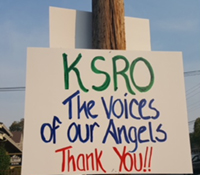Topic: Disaster Relief and Recovery
Posted on 6/1/2018
 Amaturo Sonoma Media Group’s KSRO-AM Santa Rosa played an integral role as first informers as wildfires ravished the community last October. Between midnight and 4 a.m., 43 people died and more than 10,000 homes and businesses were destroyed in Sonoma and Napa Counties. Early estimates had over 2,000 people missing. Every staff member in the cluster immediately joined KSRO’s four-person news team for commercial-free coverage across all five stations.
Amaturo Sonoma Media Group’s KSRO-AM Santa Rosa played an integral role as first informers as wildfires ravished the community last October. Between midnight and 4 a.m., 43 people died and more than 10,000 homes and businesses were destroyed in Sonoma and Napa Counties. Early estimates had over 2,000 people missing. Every staff member in the cluster immediately joined KSRO’s four-person news team for commercial-free coverage across all five stations.
Cell towers melted and utilities crumbled, leaving residents with no electricity, TV or internet. Radio became the sole method of communication. KSRO was the community’s centerpiece for emergency information: FEMA, local fire teams, the Sonoma County Sheriff’s office, Red Cross and other emergency agencies set up remote facilities in the station and parking lot, as KSRO had continuous power via generator.
“All public service agencies KNEW that our airwaves were their quickest and best route to ‘get the word out’ [about] shelters, emergency services, fire-relief, missing persons contact center, etc.,” said KSRO President Michael O’Shea.
A feature length documentary film, “Urban Inferno, The Night Santa Rosa Burned,” was produced by local physician and documentarian Stephen Seager, who wanted to tell the story of that night. The film also chronicles how local radio played a life-saving role in that disaster.
Read more stories on Disaster Relief and Recovery »
More than 2.47 million American jobs depend on broadcasting, and the local broadcast radio and television industry - and the businesses that depend on it - generate $1.17 trillion annually for the nation's economy.